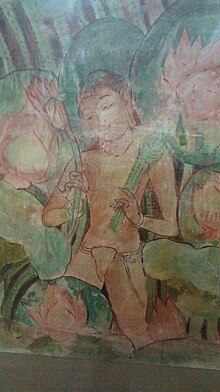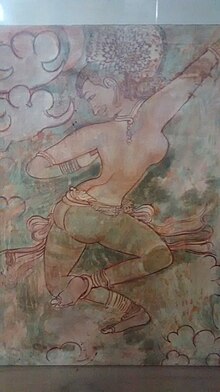
The Ajanta Caves are approximately 30 rock-cut Buddhist cave monuments dating from the 2nd century BCE to about 480 CE in the Aurangabad district of Maharashtra state in India. The caves include paintings and rock-cut sculptures described as among the finest surviving examples of ancient Indian art, particularly expressive paintings that present emotions through gesture, pose and form.
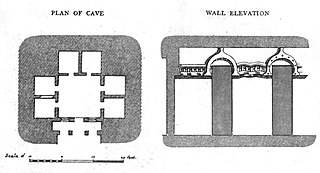
Vihāra generally refers to a Buddhist monastery for Buddhist renunciates, mostly in the Indian subcontinent. The concept is ancient and in early Sanskrit and Pali texts, it meant any arrangement of space or facilities for dwellings. The term evolved into an architectural concept wherein it refers to living quarters for monks with an open shared space or courtyard, particularly in Buddhism. The term is also found in Ajivika, Hindu and Jain monastic literature, usually referring to temporary refuge for wandering monks or nuns during the annual Indian monsoons. In modern Jainism, the monks continue to wander from town to town except during the rainy season (Chaturmas), and the term "vihara" refers to their wanderings.
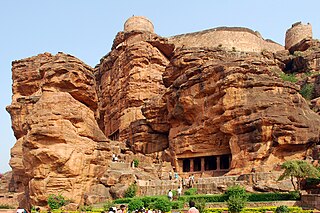
Badami, formerly known as Vatapi, is a town and headquarters of a taluk by the same name, in the Bagalkot district of Karnataka, India. It was the regal capital of the Badami Chalukyas from CE 540 to 757. It is famous for its rock cut monuments such as the Badami cave temples, as well as the structural temples such as the Bhutanatha temples, Badami Shivalaya and Jambulingesvara temple. It is located in a ravine at the foot of a rugged, red sandstone outcrop that surrounds Agastya lake. Badami has been selected as one of the heritage cities for HRIDAY - Heritage City Development and Augmentation Yojana scheme of Government of India.

The Bagh Caves are a group of nine rock-cut monuments, situated among the southern slopes of the Vindhyas in Bagh town of Dhar district in Madhya Pradesh state in central India. These monuments are located at a distance of 97 km from Dhar town. These are renowned for mural paintings by master painters of ancient India. The use of the word "cave" is a bit of a misnomer, since these are not natural, but instead examples of Indian rock-cut architecture.

Rock-cut architecture is the creation of structures, buildings, and sculptures by excavating solid rock where it naturally occurs. Intensely laborious when using ancient tools and methods, rock-cut architecture was presumably combined with quarrying the rock for use elsewhere. Though, in India and China, the terms cave and cavern are often applied to this form of man-made architecture, caves and caverns that began in natural form are not considered to be rock-cut architecture even if extensively modified. Although rock-cut structures differ from traditionally built structures in many ways, many rock-cut structures are made to replicate the facade or interior of traditional architectural forms. Interiors were usually carved out by starting at the roof of the planned space and then working downward. This technique prevents stones falling on workers below. The three main uses of rock-cut architecture were temples, tombs, and cave dwellings.

Sittanavasal Cave is a 2nd-century Tamil Śramaṇa complex of caves in Sittanavasal village in Pudukottai district of Tamil Nadu, India. Its name is a distorted form of Sit-tan-na-va-yil, a Tamil word which means "the abode of great saints".
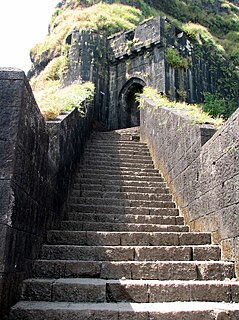
Lohagad is one of the many hill forts of Maharashtra state in India. Situated close to the hill station Lonavala and 52 km (32 mi) northwest of Pune, Lohagad rises to an elevation of 1,033 m (3,389 ft) above sea level. The fort is connected to the neighboring Visapur fort by a small range. The fort was under the Maratha empire for the majority of the time, with a short period of 5 years under the Mughal empire.

Indian rock-cut architecture is more various and found in greater abundance in that country than any other form of rock-cut architecture around the world. Rock-cut architecture is the practice of creating a structure by carving it out of solid natural rock. Rock that is not part of the structure is removed until the only rock left makes up the architectural elements of the excavated interior. Indian rock-cut architecture is mostly religious in nature.

Dulari Qureshi is an Indian academic, art historian and author. She has written more than 1,000 articles on art, culture and tourism development and its impacts on monuments. She is a retired professor and Director in the Department of Tourism Administration, Dr. Babasaheb Ambedkar Marathwada University, Aurangabad. She is also the Cultural chairperson of the Ellora-Ajanta Aurangabad Festival. One of her significant contributions is the discovery of inscriptions at Pitalkhora near Aurangabad. Qureshi is the President of Indian Tourist Congress. She is from Aurangabad, Maharashtra.
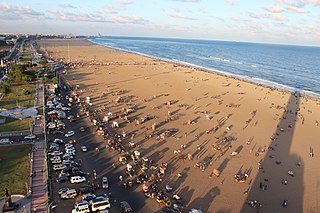
Tamil Nadu has the largest tourism industry in India with a percentage share of 21.31% and 21.86% of domestic and foreign tourist visits in the country. According to the 2020 Ministry of Tourism report, the number of domestic arrivals was at 494.8 million making the state the second most popular tourist destination in the country, and foreign arrivals numbered 6.86 million, the highest in the country, making it the most popular state for tourism in the country.

The history of cave paintings in India or rock art range from drawings and paintings from prehistoric times, beginning in the caves of Central India, typified by those at the Bhimbetka rock shelters from around 10,000 BP, to elaborate frescoes at sites such as the rock-cut artificial caves at Ajanta and Ellora, extending as late as 6th – 10th century CE.
Cholapandiyapuram or Cholavandipuram or Cholapandipuram is a 1 sq. kilometre village in Tirukkoyilur taluk in Kallakurichi district in the Indian state of Tamil Nadu. Agriculture is the primary occupation of the people who live in this area. In 2011, the village had a population of 1,000 people.

Jainism has an extensive history in the Indian state of Tamil Nadu, although practiced by a minority of Tamils in contemporary times. According to the 2011 India Census, Jains represent 0.12% of the total population of Tamil Nadu, and are of the Digambara sect. Tamil Jains are primarily concentrated in northern Tamil Nadu, in the districts of Madurai, Viluppuram, Kanchipuram, Vellore, Tiruvannamalai, Cuddalore and Thanjavur.
Neganur Patti is a 1 sq. kilometre village in Gingee taluk in Villuppuram district in the Indian state of Tamil Nadu. The major occupation of the people living at this place is agriculture. In 2012 it had a population of 3000 people.
Onampakkam is a small village in Maduranthakam taluk in Chengalpattu district in the Indian state of Tamil Nadu. The major occupation of the people living at this place is agriculture. In 2011, it had a population of 4000.
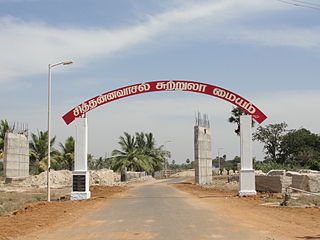
Sittanavasal is a small hamlet in Pudukkottai district of Tamil Nadu, India. It is known for the Sittanavasal Cave, a 2nd-century Jain cave complex. From the 7th to the 9th century A.D., the village flourished as a Jain centre.
Armamalai Cave is known for its Indian cave paintings. It is to the west of Malayampattu village which is 25 kilometres (16 mi) from Ambur in the Tirupattur district of Tamil Nadu. The cave is in the protected monument by the Archaeological Survey of India and it is a Tamil Nadu tourist attraction.
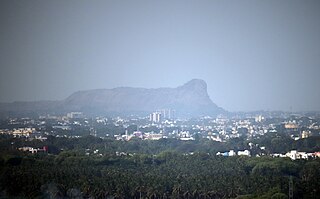
Yanaimalai is a protected monument and tourist attraction in Tamil Nadu, India. It has Jain sculptures, a Shaivite temple, and a Vaishnavite temple, namely the Narasingam Yoga Narasimha Perumal Temple.

The Buddhist caves in India. Maharashtra state Aurangabad Dist. Ellora caves form an important part of Indian rock-cut architecture, and are among the most prolific examples of rock-cut architecture around the world. There are more than 1,500 known rock cut structures in India, out of which about 1000 were made by Buddhists, 300 by Hindus, and 200 by Jains. Many of these structures contain works of art of global importance, and many later caves from the Mahayana period are adorned with exquisite stone carvings. These ancient and medieval structures represent significant achievements of structural engineering and craftsmanship.
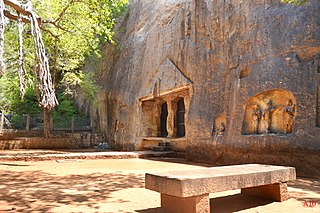
Thirupparankundram Rock-cut Cave and Inscription, also known as Umai Andar or Umaiyandar temple, is a rock cut cave temple with inscriptions at the foot of the Thirupparankundram rock hill's south face. It is located in the town of Thirupparankundram, about 10 kilometres (6.2 mi) southwest of Madurai city, Tamil Nadu, India. It consists of several layers of construction, the earliest is dated to the 8th-century early Pandya period, and the last to the 13th century.
